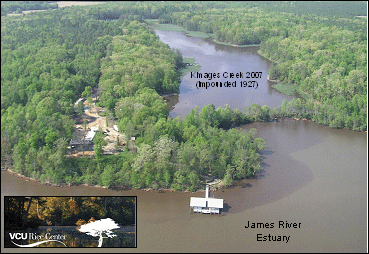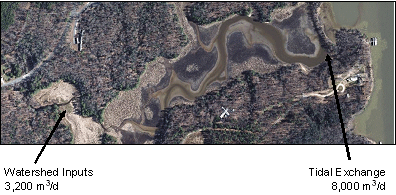

| Research
James River
Ecosystem Study ||
Restoration of Kimages Creek Restoration of Kimages Creek In 1927 a dam was built at the confluence between Kimages Creek and the James River to create a 179 acre impoundment (Lake Charles). The impoundment persisted until October 2007 when the dam was partially breached following a period of heavy rain. In the first weeks, the lake lost approximately two-thirds of its volume and one-third of its surface area. This restored flowing conditions to the upper (non-tidal) section of the creek. Over subsequent months, out-flowing water continued to drain from the lake and erode the dam. By Spring 2008, the breach had incised to a depth below the high-tide water level of the James resulting in a reversal of flow and the restoration of tidal exchange between Kimages Creek and the James River. The tidal portion of Kimages Creek is located on the property of the VCU Rice Center. The tidal stream is approximately 1300 m in length, ranges 5 to 40 m in width and has an average depth of 0.5 m. The narrow dam breach provided a location at which the exchange of water between Kimages and the James River could be accurately measured. We took advantage of this unplanned restoration experiment to investigate the functioning of Kimages Creek, and specifically, its capacity to retain nitrogen. We measured the amount of N entering and leaving the Creek over a tidal cycle to determine whether Kimages was a net source or sink of N. These measurements were performed monthly over an annual cycle to determine whether there were seasonal patterns in retention. We found that water exchange in Kimages Creek was dominated by tidal fluxes but that these were highly variable. During periods when water level in the James was elevated, the volume of tidal exchange was 20-fold higher. Water levels in the James were responsive to local events (e.g., rainfall in the river catchment) as well as regional factors influencing sea level (e.g., wind forcing of coastal ocean). The importance of events in influencing fluxes is well-established for non-tidal streams but our work shows that tidal streams are also greatly affected and that these events may originate outside the watershed. The tidal stream was a net source of dissolved inorganic N during winter months but a net sink overall. The direction and rate of N transformation was found to be significantly related to temperature and ecosystem metabolism (production and respiration). Overall, restoration of tidal exchange to Kimages Creek resulted in a 20-fold increase in water and N fluxes and a two-fold increase in N retention.
|

